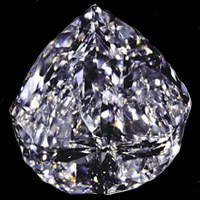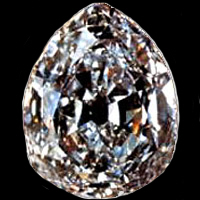




Looking After Your Finds - Reference

Powered By Sispro1
Designed by Nigel G Wilcox
Famous Diamonds

The Centenary Diamond

The Centenary Diamond
The Centenary was established on July 17th, 1986 by the electric X-ray recuperation classification at the Premier Mine. Only a handful of populace knew about it and all were avowed to silence. In its coarse form it resembled an asymmetrical matchbox with lanky planes, a well-known stretched out "horn" jutting out at solitary corner and a profound concave on the principal horizontal surface. The shape of the precious stone articulated issues in cutting with no obvious explanation.
Centenary DiamondsThe man chosen to appraise the Centenary was Gabi Tolkowsky, well-known in the diamond business as one of the mainly talented cutters in the planet. His family had long been in the diamond employment and it was his great-uncle, Marcel Tolkowsky, diamond specialist and mathematician, who launched a book in 1919 titled "Diamond Design", which for the 1st time set out precise ways of wounding the modern round dazzling cut.
Gabi Tolkowsky himself was the inventor of 5 innovative diamond cuts, exposed in 1988, which ponder onmaximizing brilliancy, shade or acquiesces or an amalgamation of all 3 from off-color jagged diamonds previously considered tricky to cut gainfully into predictable round or conjure shapes. Named for flowers, the cuts are mostly based on untraditional slant dimensions. The overall magnitude as well as the usage of more facets in the order of the pavilion augment intensity and advance visual collision when viewed face-up.
When cutting was accomplished the Centenary weighed 273.85 carats, calculated 39.90 50.50 24.55 mm, and had 247 facets - 164 on the rock and 83 around its restraint. Never before, had such an elevated number of facets been refined onto a diamond. In adding together, 2 faultless pear shapes weighing 1.47 and 1.14 carats were slashed from the coarse. Among top-color diamonds the Centenary is surpassed only by the Cullinan I (also known as the Star of Africa) and the Cullinan II, which were incise from the Cullinan crystal previous to modern symmetrical cuts were completely urbanized in the 1920's, building the Centenary the principal contemporary fancy cut diamond in the globe and the only one to coalesce the oldest techniques - such as kerfing - with the mainly complicated contemporary technology in cutting.
The Centenary was established on July 17th, 1986 by the electric X-ray recuperation classification at the Premier Mine. Only a handful of populace knew about it and all were avowed to silence. In its coarse form it resembled an asymmetrical matchbox with lanky planes, a well-known stretched out "horn" jutting out at solitary corner and a profound concave on the principal horizontal surface. The shape of the precious stone articulated issues in cutting with no obvious explanation.
Centenary DiamondsThe man chosen to appraise the Centenary was Gabi Tolkowsky, well-known in the diamond business as one of the mainly talented cutters in the planet. His family had long been in the diamond employment and it was his great-uncle, Marcel Tolkowsky, diamond specialist and mathematician, who launched a book in 1919 titled "Diamond Design", which for the 1st time set out precise ways of wounding the modern round dazzling cut.
Gabi Tolkowsky himself was the inventor of 5 innovative diamond cuts, exposed in 1988, which ponder onmaximizing brilliancy, shade or acquiesces or an amalgamation of all 3 from off-color jagged diamonds previously considered tricky to cut gainfully into predictable round or conjure shapes. Named for flowers, the cuts are mostly based on untraditional slant dimensions. The overall magnitude as well as the usage of more facets in the order of the pavilion augment intensity and advance visual collision when viewed face-up.
When cutting was accomplished the Centenary weighed 273.85 carats, calculated 39.90 50.50 24.55 mm, and had 247 facets - 164 on the rock and 83 around its restraint. Never before, had such an elevated number of facets been refined onto a diamond. In adding together, 2 faultless pear shapes weighing 1.47 and 1.14 carats were slashed from the coarse. Among top-color diamonds the Centenary is surpassed only by the Cullinan I (also known as the Star of Africa) and the Cullinan II, which were incise from the Cullinan crystal previous to modern symmetrical cuts were completely urbanized in the 1920's, building the Centenary the principal contemporary fancy cut diamond in the globe and the only one to coalesce the oldest techniques - such as kerfing - with the mainly complicated contemporary technology in cutting.

The 'Cullian' Diamond
The 'Cullian' Diamond
The great Star of Africa or "Cullinan" diamond was established in the year 1905, in the leading Mine at Pretoria, South Africa, and possessed its name from Mr. T. M. Cullinan, then one of the principal officials of the African mine when the precious finding happened. It was then taken over by the Union Government of South Africa, and offered to Edward VII. To be studded on to the Crown Jewels of the kingdom. The coarse diamond was cut into 4 grand brilliants and several smaller ones.
The principal fraction is drop-shaped, It weighs in at 516 1/2 carats, and dimensions to 2 5-16th inches in length and 1 13- 16th at its broadest section. It is positioned in the cranium of the King's Sceptre. The 2nd major fraction is positioned in the band of the King's State Crown, just positioned underneath the Black Prince's ruby. The 3rd and 4th portions were deposited in Queen Mary's Crown.
The premature narration of the Stuart sapphire is to some extent incomprehensible, though it in all probability belonged to Charles II., and was unquestionably in the middle of the royal Jewels which James II., treasured to take with him when he fled to France. From him it conceded to his son, Charles Edward, the elderly opponent, who bestowed it to his son, Henry Bentinck, identified later on as Cardinal York. The Stuart basis being dead Cardinal York left the sapphire with supplementary Stuart vestiges, to be then taken over by George III.
In Queen Victoria's State coronet this fine precious stone engaged an outstanding location in the frontage of the band just beneath the Black Prince's ruby. This pride of position it relinquished in favor of the Star of Africa and now positions a precisely reverse setting at the reverse of the King's State Crown.
The sapphire of St. Edward in the middle of the cross pat e on the pinnacle of the King's State coronet is seized to encompass in the Coronation Ring of Edward the Confessor, who mounted the Throne in 1042. How the precious stone and ring passed all the way through the terrible desolation of the Commonwealth is not apparent, but a diminutive editorial of this sort might with no trouble break out unnoticed, concealed, as was the Ampulla, in Westminster Abbey, or masked by some dedicated aficionado of the Stuarts. It was hypothetical in the older days to comprise the magic supremacy of therapeutic towards cramp.
The great Star of Africa or "Cullinan" diamond was established in the year 1905, in the leading Mine at Pretoria, South Africa, and possessed its name from Mr. T. M. Cullinan, then one of the principal officials of the African mine when the precious finding happened. It was then taken over by the Union Government of South Africa, and offered to Edward VII. To be studded on to the Crown Jewels of the kingdom. The coarse diamond was cut into 4 grand brilliants and several smaller ones.
The principal fraction is drop-shaped, It weighs in at 516 1/2 carats, and dimensions to 2 5-16th inches in length and 1 13- 16th at its broadest section. It is positioned in the cranium of the King's Sceptre. The 2nd major fraction is positioned in the band of the King's State Crown, just positioned underneath the Black Prince's ruby. The 3rd and 4th portions were deposited in Queen Mary's Crown.
The premature narration of the Stuart sapphire is to some extent incomprehensible, though it in all probability belonged to Charles II., and was unquestionably in the middle of the royal Jewels which James II., treasured to take with him when he fled to France. From him it conceded to his son, Charles Edward, the elderly opponent, who bestowed it to his son, Henry Bentinck, identified later on as Cardinal York. The Stuart basis being dead Cardinal York left the sapphire with supplementary Stuart vestiges, to be then taken over by George III.
In Queen Victoria's State coronet this fine precious stone engaged an outstanding location in the frontage of the band just beneath the Black Prince's ruby. This pride of position it relinquished in favor of the Star of Africa and now positions a precisely reverse setting at the reverse of the King's State Crown.
The sapphire of St. Edward in the middle of the cross pat e on the pinnacle of the King's State coronet is seized to encompass in the Coronation Ring of Edward the Confessor, who mounted the Throne in 1042. How the precious stone and ring passed all the way through the terrible desolation of the Commonwealth is not apparent, but a diminutive editorial of this sort might with no trouble break out unnoticed, concealed, as was the Ampulla, in Westminster Abbey, or masked by some dedicated aficionado of the Stuarts. It was hypothetical in the older days to comprise the magic supremacy of therapeutic towards cramp.
_01.jpg)
The Kohinoor Diamond
Copyright All Rights Reserved by Nigel G Wilcox E-Mail: ngwilcox100@gmail.com
Rocks & Minerals Menu
Complimentary Topics
The Paragon Of Metal Detecting
& Archaeology
& Archaeology
Who Owns the World's Gold?
Group Pages
[2]
[3]
[4]
[5]
[6]
[7]
[8]
Famous Diamonds
Pages
Member NCMD
Reference Menu




















